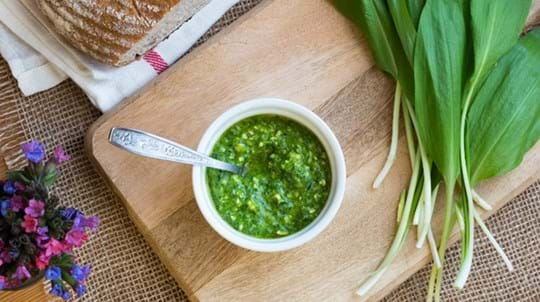
Visiting woods
Foraging: what to look out for each month
See what's in season with our guide to sustainable foraging with top tips on how to pick, cook and eat wild plants.

Content manager, botanist and tree lover
Midsummer is a magical time for collecting edible wild plants. You can spend warm days and long, light evenings foraging for surprising edible ingredients.
From garden weeds to crisp seeds, here are my June top tips on what to forage, where to find it and what to do.
Ash is one of our most common trees and together with privet they are the only UK representatives of the olive family (Oleaceae). The young, green, immature seeds of ash, known as keys, are edible and have also been used in herbal medicine. They often hang in generous bunches at this time of year.
How to use it: you’ll need to pick the seeds early to guarantee success. The process involves boiling the keys to extract their bitterness and then pickling with vinegar, sugar and spices. There are several recipes online.
What to look for: pick the seeds when they are very young and green before they develop stringy fibres. To test the tenderness, snap through an ash key to ensure it is crisp and not fibrous.
For many people, fragrant elderflowers are synonymous with summer and they’re at their best late May to June depending on where you are in the UK. The flowers and berries are the only edible part of the elder tree and require cooking to remove the small amounts of toxic chemicals.
How to use it: pick the flowers, give them a shake to remove any insects and rinse briefly in cold water before using. They can be used fresh as flavouring for cordial, wine, tea, liqueur, syrup, jelly and desserts. You can also dip the flowers into a light batter and fry them to make elderflower fritters. Alternatively dry the flowers and use them as a substitute for fresh flowers in most recipes.
What to look for: look for elder trees in woodland, scrub, hedgerows and on wasteland. Their creamy-white flowers hang in flat-topped clusters. Pick when the buds are freshly open on a warm, dry, sunny day, well away from traffic fumes.
This perennial herb is so-called because its leaves resemble those of the elder tree (Sambucus nigra). But it's also known by a host of other names that reflect its history as a medicinal plant and more recently, its reputation as a weed. They include goutweed, dog elder, herb Gerard and Devil's guts.
Ground elder isn't native to the UK and was first introduced from continental Europe, probably by the Romans, as a potherb and remedy against gout. It was once a cultivated and valued plant and although its traditional uses have dwindled, the plant hasn't. It's now classed as an invasive weed and is an irritation to many gardeners who fight a continuous battle with its persistent roots. Why not, then, embrace it as a food plant?
How to use it: very versatile with a similar flavour to parsley that goes well with fish. Eat the young leaves and shoots raw or add to salads and sandwiches. You can cook the leaves in a similar way to spinach by steaming or softening in butter. Or add them to anything you're making like soups, stews, bubble and squeak and pasta dishes.
What to look for: it's widespread and common in shady places under hedgerows, in gardens, woodlands, hedgerows and along lanes. Look for its luxuriant green leaves that often form thick carpets. It's around for much of the year, but in June the leaves are particularly lush and tender. It's not difficult to identify but it is in the same family (Apiaceae) as some poisonous plants. When identifying ground elder look for serrated, oval leaves which are in groups of three on a grooved stalk. The plant grows close to the ground.
Ground elder is an invasive plant and can be easily and unwittingly spread. Avoid putting any roots or root fragments in your compost bin.
Woods in summer are often filled with the delicious scent of honeysuckle. This beautiful, fragrant wildflower has edible blooms that can be used to infuse a sweet, honeyed flavour into many dishes.
How to use it: you only need a few flowers to capture their essence. Use them to infuse water to make refreshing tea, sorbets, cordials or jams and jellies. Make simple syrup with honeysuckle flowers that can be used to make vinaigrette, or added to cocktails, gin, champagne and chilled fizzy water. Don't eat the berries - they may be mildly toxic, especially in introduced garden varieties.
What to look for: honeysuckle is a common climbing plant of old hedgerows and woodland edges. Its red-tinted, trumpet-shaped flowers appear from June to September.
The flowers (lime blossom) of lime trees have a sweet honey-like aroma and have been used as a food and medicine. The flowers have mild sedative and anti-anxiety properties and were administered in the field hospitals of the Second World War.
How to use it: gather lime flowers in full bloom in June and July. You can add fresh flowers to salads or dry them and bake them into cakes and breads or use to make herbal teas. Lime tea has a sweet taste and is particularly popular in France where they call it tilleul. Its calming properties make it a good bedtime drink.
What to look for: Tilia species are large deciduous trees which can be found across the UK often planted in parks and gardens. The small yellow-white flowers are attached to a wing-like bract. They generally flower in June and July.
Petals from all types of rose, like dog rose, are edible, and have a slightly fruity flavour that can be used to make syrups or jellies. Avoid any that may have been sprayed with pesticides.
How to use it: use the petals raw in salads. Infuse in vinegar, make jam or crystallise. Dry the petals and use in Middle Eastern and Asian dishes.
What to look for: look for dog rose (Rosa canina) in hedges and scrub. It grows up to 3m with curved thorns. Its pink flowers appear from June to July. Field rose (Rosa arvensis) is similar, but smaller with white flowers. It’s best to pick the flowers as they start to drop.
Also known as wild chamomile, this plant smells strongly of pineapple and has a sweet, pineapple flavour. Pineapple weed is not native to the UK and was first recorded in the wild in Britain as an escape from Kew Gardens in 1871. It became one of the fastest spreading plants in the 20th century.
How to use it: pick the flower heads when they are young, before they develop a bitter taste. The fresh or dried flower heads of pineapple weed can be used to make herb tea (similar to its close relative, chamomile) and the fresh flowers can be eaten raw in salads or cooked. Its leaves can be added to salads or just nibbled when you’re out walking.
What to look for: it grows on poor, compacted soil around footpaths, field entrances, waste ground and through cracked tarmac on road sides. Look for its feathery leaves and daisy-like flowers with dome-shaped yellow-green corollas.
Dandelion, chickweed, fat hen, nettle, mallow, oxeye daisy, red clover, sorrel, garlic mustard, sweet violet, wild garlic.